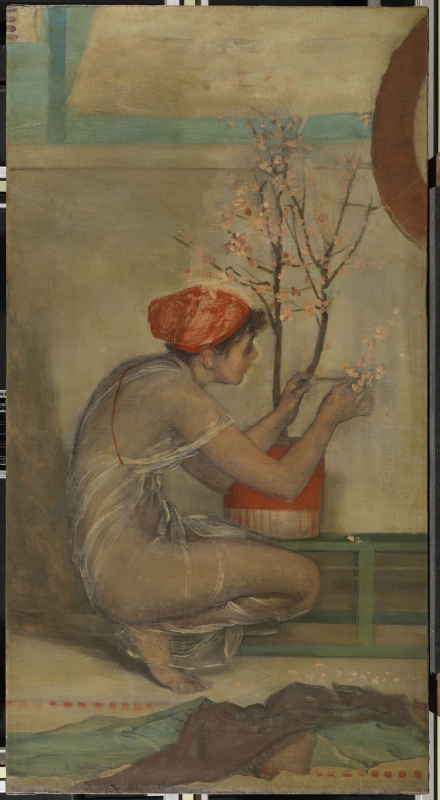Home > Catalogue > Browse > Girl with Cherry Blossom << >>
Composition
Girl with Cherry Blossom was probably cut by Whistler from The Three Girls [YMSM 088]. This is confirmed by X-radiographs that show the presence of part of the standing figure from the original composition, standing to the left of the crouching figure.
The presence of paint on the stretcher, carried over from the canvas, suggests that Whistler finished work on Girl with Cherry Blossom [YMSM 090] only after cutting it from the original canvas. It is difficult to establish when this occurred because of discrepancies in the provenance.
Girl with Cherry Blossom [YMSM 090] is more thickly painted, brightly coloured, and highly finished than the copy made by Whistler in 1879, Pink and Grey: Three Figures [YMSM 089].
The crouching girl in The White Symphony: Three Girls [YMSM 087], which was a study for the original canvas of The Three Girls [YMSM 088], shares details of pose and dress with Girl with Cherry Blossom [YMSM 090]. However, the crouching figure in Pink and Grey: Three Figures [YMSM 089], which was a copy of The Three Girls, is slightly different. On the other hand, the extremely diaphanous dress in Girl with Cherry Blossom is similar to that in the copy.
Drawings such as The Lily [M.0364], and the much later Rose et argent: Fleurs de printemps [M.1391], show that the subject of a crouching figure and flowers was one to which Whistler frequently returned.
Technique
The Freer Gallery of Art website states categorically:
'This fragment, cut from the original canvas, is all that remains of Whistler’s painting The Three Girls. The ghostly silhouette of brushstrokes around the girl’s head and the overworked yet still unresolved forms of her fingers and toes confirm the artist’s struggle to perfect each detail. They also suggest that even at this advanced stage, the painting remained unfinished.' 1
The paint was mostly applied quite thinly, but then reworked. Areas on and around the figure were painted, rubbed down, and sometimes retouched, producing a curious mixture of blurred and finished areas. Some details, such as the blossom, were painted with blobs of thicker paint from a rounded brush. Paint on the stretcher, carried over from the canvas, suggests that Whistler continued to work on the fragment after it was cut from the original canvas.
Conservation History
The Freer Gallery website comments:
'From 1867 until 1877, Whistler painted, scraped, repainted, and finally destroyed The Three Girls, even though Leyland had already paid him for the picture. The artist was never satisfied with a work of art that appeared supremely beautiful to all eyes but his own. Whistler’s mother Anna, who was then living in London, astutely identified the problem: the painting eluded him precisely because “he had tried too hard to make it the perfection of art.”' 2
Frame
A Flat Whistler frame, the frieze decorated with an incised whorl motif. 3 This painting was probably cut down from the larger figure composition, The Three Girls [YMSM 088], and was not exhibited by Whistler. He may have used the frame from another painting or had one cut down to size.
Last updated: 15th December 2020 by Margaret













